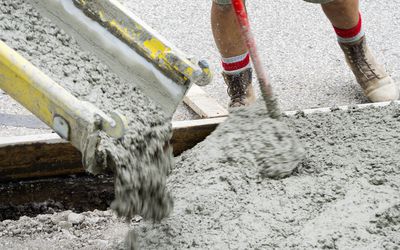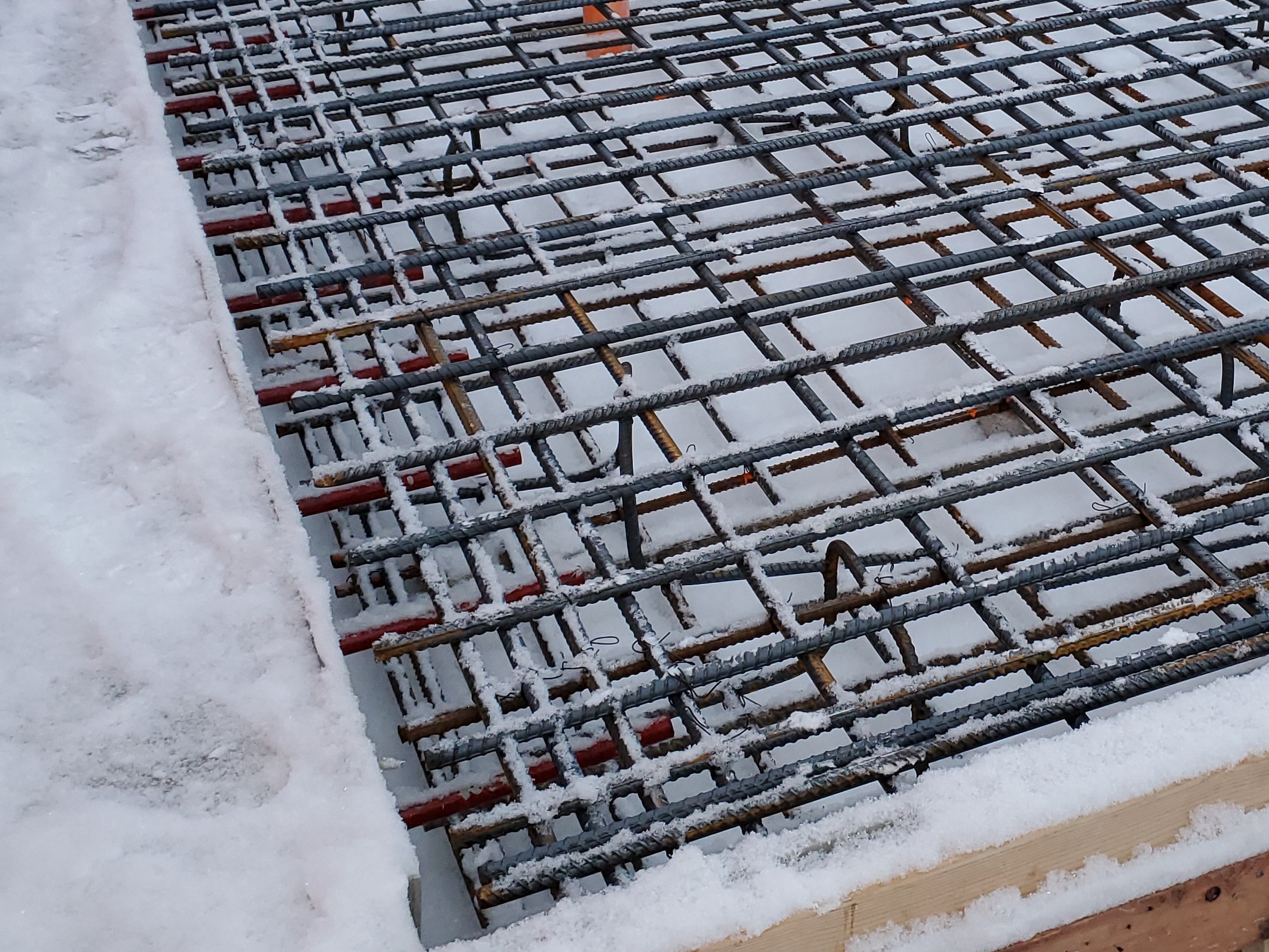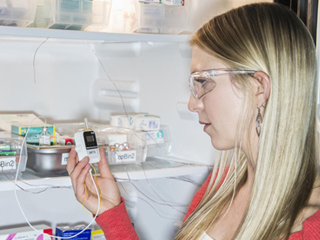
Photo Credit: trpreadymix.com
Environmental conditions are an uncontrollable yet important factor during cold weather concrete temperature monitoring. The concrete curing process is highly dependent on how hot or cold the temperature is. During cold weather, it introduces significant impacts on the strength and longevity of the concrete structure.
However, the construction process cannot halt during the winter months. These projects require strict compliance with their turnover schedule. Good thing that concreting is possible provided that extra precautions are taken in the process. Minimum temperature during mixing and placement needs to be regulated. This aims to achieve adequate strength. The first few days after placing concrete is also critical. This is the time when the hydration reaction occurs. The concrete gains most of its final strength as waters come in contact with concrete. In cold weather, where the hydration process slows, monitoring using temperature sensors is the key to build a quality structure on time. By monitoring, you can protect the concrete from freezing, avoid thermal cracks, and ensure proper curing.
Protect the Concrete from Freezing

Photo Credit: www.thebalancesmb.com
The concrete’s minimum compressive strength is 500 pounds per square inch (psi). It is achieved within the first 24 hours after placement. Until the concrete reaches this state, utmost protection from freezing is important. Water usually freezes at around -3 to -4°C, and at this point, hydration will stop. When water within the concrete freezes, the strength will be compromised, reducing it up to 50%. Inadequate strength cannot withstand the expansive forces of freezing water. Freshly poured concrete can be damaged at dropping temperatures. The frozen water will disrupt the formulation of the cement paste matrix. Cement paste is the combination of all the particles mixed with cement. Examples are sand, gravel, and bitumen to form a concrete mass. The ice can expand at 9% of its volume as it forms, disrupting the freshly poured concrete by the ice crystals.
Avoid Thermal Cracking
Another risk of cold weather concreting is the excessive temperature differential. The temperature differential is the difference on the surface and inner core of the concrete. Contractors should maintain the temperature of the ground, concrete, and ambient within the specifications. Heated concrete should not be exposed to a rapid change in temperature. In this case, exposure to a cold temperature can cause thermal cracks. During cold weather, the ambient temperature is far below the optimal temperature of 35ºF. Therefore, strict monitoring is important.
Proper Concrete Curing Process
Cold weather makes the concrete curing and setting time slower, affecting the strength. Setting time will be doubled if the temperature drops by 10 degrees Celsius. For Cold weather, bleeding also starts later with more bleeding water than usual. Bleeding is the process when water on the mix is pushed upward as the water and cement bind together. If finishing is done before water evaporates and the excess bleeding water is not handled correctly, it can be problematic.
For concrete to cure properly, you must maintain a minimum of 40 degrees Celsius, depending on the thickness of the concrete. Higher temperature is maintained, especially for thinner concrete pours and cold weather conditions. The thicker the concrete, the less minimum temperature is required. Temperature can be verified by monitoring using a concrete temperature sensor.
· 40 degrees – more than 72 inches
· 45 degrees – 36 to 72 inches
· 50 degrees – 12 to 36 inches
· 55 degrees – less than 12 inches
Track Concrete Maturity
As concrete has slower strength development in cold weather, it must track its maturity. By monitoring the temperature, you will gain insight when the concrete already acquired adequate strength to proceed with the construction process. This reduces the risk of premature structural failure.
How to Protect Concrete on Cold Weather?
Cold weather is a period when the average temperature drops below 4 degrees Celsius. By this time, concrete must be protected by implementing the cold weather concrete temperature practices. The surface, edges, and corners are the most vulnerable to low temperature. These areas are the most critical to protect. The required degree of protection increases as the ambient temperature becomes lower. Concrete that is properly produced, placed, and protected will gain adequate strength despite the freezing temperature. Here are ways on how to protect your concrete in cold weather.
-
·Removing Ice and Snow
The fresh concrete should not be poured on the frozen ground. Putting a cover and insulator is a way to prevent ice from falling on your work area. Frost blanket can be used as protection. The frozen ground will settle as it thaws, which will make your concrete risky for cracking. If ice has already fallen on the surface of the formworks and rebar, removing it before proceeding is important. Concrete that is placed on a cold surface will make the setting time longer.

Photo credit: www.fprimec.com
-
The proper way of Heating Materials
Aside from keeping the area free from snow, it also important to ensure that the materials used in the building are warm. Tools and equipment are used to heat materials such as water and aggregate to counter the freezing temperature. For warm water, the temperature should be around 25-30°C to increase the temperature mix. If the temperature goes beyond 49°C, the bond strength and compressive strength will be reduced.
However, heaters should be used correctly to avoid damages. For instance, proper ventilation is important if using a fuel-fired heater. Carbonation can happen due to the carbon dioxide given off in the exhaust. This can make the surface of concrete dusty and weak. A ground heater is also used to keep the ground warm before pouring the concrete. It thaws the ground while maintaining warm temperatures for the concrete throughout curing procedures.
-
Monitoring Temperature
One of the priorities of contractors when concreting on cold weather is maintaining the temperature. The cold weather concrete temperature should not go beyond the threshold of 10-25 degrees Celsius. To ensure that the temperature is within the specified requirements, temperature monitoring is done before, during, and after concreting. For example, it is critical to avoid sudden temperature changes after the curing process. As mentioned, a shock may happen if the concrete is suddenly exposed to the cold ambient air. Massive concrete also requires several weeks of temperature monitoring. This is to maintain gradual cooling.
Analyzing the temperature is the first step in knowing how much supplementary heat is needed for the concrete to gain adequate strength. Contractors can make decisions and take actions based on the temperature curve. They can also see if precautions are taken accordingly and if there’s a necessary adjustment. By monitoring temperature, reduced weakness, and the abovementioned damages to the concrete can be prevented.
Using Temperature Sensors on Cold Weather Concreting
Cold Weather Concreting practices aim to overcome the challenges of low temperature on concreting. The success of these practices rests on the accuracy of the temperature data.
Temperature Sensors are designed to help workers gather temperature data. Data is important to implement these practices properly. With temperature sensors, workers are provided with accurate data on the temperature condition over a specific period. They measure the temperature of the ambient air, concrete structure, and the building materials used. This means an easier way of having insight into when and where a specific action must be taken. Data is transferred to a device through a graph for easier analysis and understanding. This allows the site engineers to make a correct and sound decision.
Another reason why use temperature sensor is to be proactive. Temperature sensors allow workers to track the condition of the concrete. Is the temperature dropping too much? Or does the material require additional heating? When the temperature reached its limit, it will send a notification to the worker. This gives them ample time to decide on what measure to apply before irreparable damage occurs.
From the traditional cabled sensors, technology has now innovated wireless sensors. With this type of sensor, the collection and analysis of data are much faster and easier. The sensor is embedded in the concrete. But through wireless technology, officers can access the data through a mobile application. Recording of data is not a hassle work anymore. Files can be easily downloaded and shared with other people of concern. This ensures timely and well-informed insights from each of them.
AKCP Wireless Temperature

Wireless Temperature Sensor
An early-stage investment is the foundation of your concrete’s long-term durability. Yes, the impact of cold weather concrete temperature monitoring is admittedly terrible from its earlier years. Today, as technology continuously moves forward, you may find options of monitoring solutions to serve your purpose. If you seek to protect your project’s quality, ask our sales representatives, and they shall be happy to tell you more about our AKCP Temperature Sensor.
AKCP Temperature Sensor is built-in with Calibration Check. Wireless Tunnel™ NIST2 sensors feature 2x NIST traceable, calibrated temperature sensors in a single stainless steel tube. Working as a pair, they check each other’s values once a second for accuracy. It provides you data that is needed in planning and implementing your cold-weather concreting strategies. Therefore, ensuring maximum protection from the threat of cold weather.
Reference Links:
https://www.roadstone.ie/concrete-cold-weather-guidelines/





